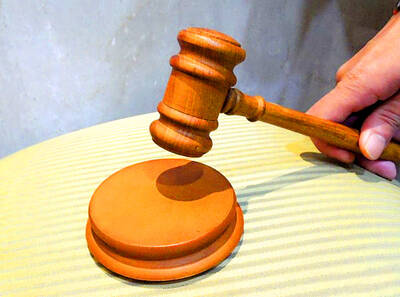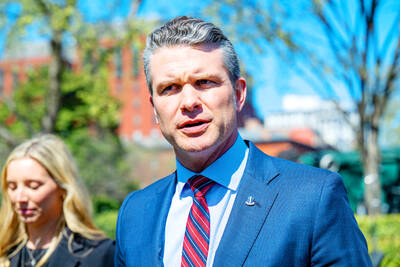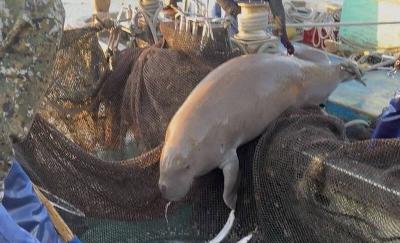Lawmakers yesterday called for the removal or replacement of a map in the Legislative Yuan which places the capital of the Republic of China (ROC) in Nanjing, and portrays Mongolia as part of its territory.
Replacing the map with one that accurately reflects the nation is an important first step before tackling other issues, such as moving the Legislative Yuan or amending the Constitution, Democratic Progressive Party (DPP) Legislator Chen Ting-fei (陳亭妃) said.
The map, near a stairwell in one of the legislature’s buildings, often appears on TV when reporters interview legislators.

Photo: Wu Su-wei, Taipei Times
It was put up in 2016 after a previous map had been defaced, and the Chinese characters for “Taiwan” removed, a source said.
As officials were unable to purchase a replacement map large enough, they sourced one from the military, which was older with outdated markings, the source said.
Authorities at the time appended the map with the statement: “The boundaries on this map do not conform to political fact.”
“With the way it portrays the ROC territory, that map is like one from a parallel universe — it is out of step with current thinking,” Chen said.
DPP Legislator Tsai Shih-ying (蔡適應) said that the map would only “lead people to engage in fantasies,” and called on the legislature to replace it.
Hanging a factually inaccurate map in the legislature was meaningless, he said.
“That map might be confusing for foreign visitors or members of the public, especially since the map depicts Taiwan on the periphery of the ROC,” New Power Party Legislator Chiu Hsien-chih (邱顯智) said, adding that this was “unfair to the 23 million people” of Taiwan.
Chinese Nationalist Party (KMT) Legislator William Tseng (曾銘宗) said that the map is accurate, until the Constitution and laws are amended to change the nation’s official territory.
The legislature should proceed cautiously and hear the various opinions on the matter before replacing the map, he said.
Legislative Yuan Secretary-General Lin Chih-chia (林志嘉) said the legislature was already discussing the issue, and that if it could find a suitable map it would replace it.

The High Prosecutors’ Office yesterday withdrew an appeal against the acquittal of a former bank manager 22 years after his death, marking Taiwan’s first instance of prosecutors rendering posthumous justice to a wrongfully convicted defendant. Chu Ching-en (諸慶恩) — formerly a manager at the Taipei branch of BNP Paribas — was in 1999 accused by Weng Mao-chung (翁茂鍾), then-president of Chia Her Industrial Co, of forging a request for a fixed deposit of US$10 million by I-Hwa Industrial Co, a subsidiary of Chia Her, which was used as collateral. Chu was ruled not guilty in the first trial, but was found guilty

DEADLOCK: As the commission is unable to forum a quorum to review license renewal applications, the channel operators are not at fault and can air past their license date The National Communications Commission (NCC) yesterday said that the Public Television Service (PTS) and 36 other television and radio broadcasters could continue airing, despite the commission’s inability to meet a quorum to review their license renewal applications. The licenses of PTS and the other channels are set to expire between this month and June. The National Communications Commission Organization Act (國家通訊傳播委員會組織法) stipulates that the commission must meet the mandated quorum of four to hold a valid meeting. The seven-member commission currently has only three commissioners. “We have informed the channel operators of the progress we have made in reviewing their license renewal applications, and

‘DENIAL DEFENSE’: The US would increase its military presence with uncrewed ships, and submarines, while boosting defense in the Indo-Pacific, a Pete Hegseth memo said The US is reorienting its military strategy to focus primarily on deterring a potential Chinese invasion of Taiwan, a memo signed by US Secretary of Defense Pete Hegseth showed. The memo also called on Taiwan to increase its defense spending. The document, known as the “Interim National Defense Strategic Guidance,” was distributed this month and detailed the national defense plans of US President Donald Trump’s administration, an article in the Washington Post said on Saturday. It outlines how the US can prepare for a potential war with China and defend itself from threats in the “near abroad,” including Greenland and the Panama

A wild live dugong was found in Taiwan for the first time in 88 years, after it was accidentally caught by a fisher’s net on Tuesday in Yilan County’s Fenniaolin (粉鳥林). This is the first sighting of the species in Taiwan since 1937, having already been considered “extinct” in the country and considered as “vulnerable” by the International Union for Conservation of Nature. A fisher surnamed Chen (陳) went to Fenniaolin to collect the fish in his netting, but instead caught a 3m long, 500kg dugong. The fisher released the animal back into the wild, not realizing it was an endangered species at